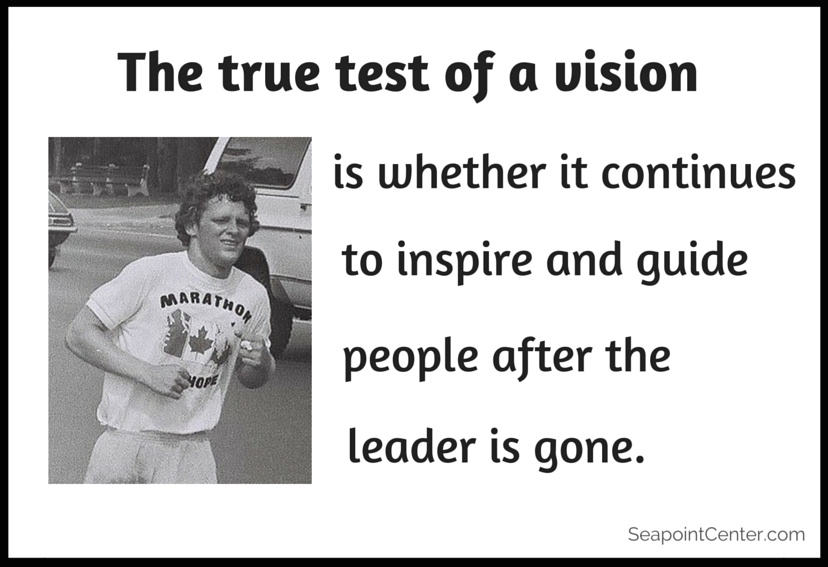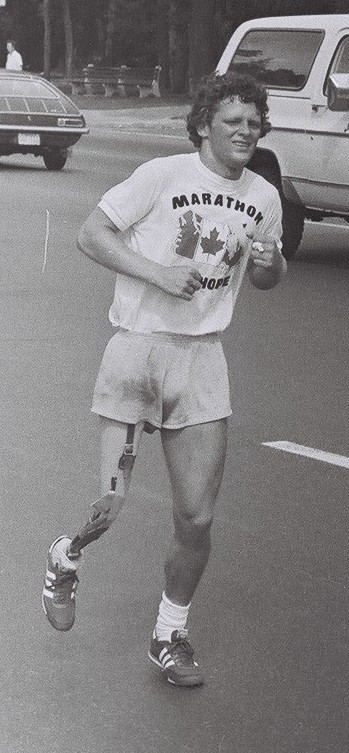 The true test of a vision is whether it continues to inspire and guide people after the leader is gone.
The true test of a vision is whether it continues to inspire and guide people after the leader is gone.
Consider the seamless transition at Southwest Airlines when founder Herb Kelleher stepped down compared with Disney’s two decades of floundering after the death of Walt Disney. Time and again, we see examples of companies that suffer when their charismatic leader leaves without having instilled a true vision.
In looking for examples of true vision, we usually draw on the vision of a few great leaders like Martin Luther King, Jr., Mahatma Gandhi, or Nelson Mandela
But passing the test of a vision is not as rare as it might seem. There are many wonderful examples of people whose story isn’t well-known, but whose vision has made a significant impact.
Terry Fox was a young man whose vision met this test.
Terry was awarded Athlete of the Year in 1975, his senior year of high school in British Columbia, Canada.
A few months after graduation, he discovered he had a malignant tumor, and his right leg was amputated four days later.

The night before his operation, he read a magazine article about an amputee who ran in the New York marathon. That night, Terry dreamed about running across Canada.
During his followup treatment, he was deeply affected by the suffering he witnessed at the cancer clinic, and his dream transformed into a vision – to run across Canada to raise a million dollars to fight cancer AND to change people’s attitudes toward people with disabilities by demonstrating what an amputee could do.
Terry trained every day for fifteen grueling months, until he could run twenty-three miles a day. Then, on April 12, 1980, he dipped his artificial leg in the Atlantic Ocean in St. John’s, Newfoundland, and began his run.
Terry became a national hero. He was greeted with cheers as he entered each town. People wept as he ran by with his fists clenched, eyes focused on the road ahead, and his awkward double-step and hop sounding down the highway. He didn’t try cover his artificial leg. He wanted people to see it was part of who he was.
He’d start before dawn every day, running in shorts and a T-shirt printed with a map of Canada. He didn’t hide his disability. His artificial leg was fully visible. Children were curious about his artificial leg. How did it work? What happens when it breaks? He encouraged them to ask questions and always stopped to answer them.
The donations poured in.
Terry ran 3,339 miles from Newfoundland, through six provinces. He was two-thirds of the way home, running close to a marathon a day for 144 days straight.
But on September 1, 1980, Terry had to stop. His cancer had recurred and had spread to his lungs. He flew home for treatment. And with his family beside him, Terry Fox died on June 28, 1981 — one month short of his 23rd birthday.
Did Terry achieve his vision?
Terry did not complete his Marathon of Hope. But that wasn’t his vision. Running across Canada was his plan for how he would achieve his vision.
Terry’s vision was to raise $1 million dollars for cancer research and to increase awareness about disabilities.
In fact, Terry raised $23.4 million! And people everywhere saw him as an athlete and a hero, not a person with a disability.
The true test of a vision is that Terry’s vision didn’t end.
Terry’s vision continues to inspire people to help raise money for cancer research. Over the years, the annual Terry Fox Run has raised over $700 million. Last September marked its 35th anniversary.
If you’re from Canada, most likely you already know the story of Terry Fox. If you would like to know more about Terry’s story, this ESPN video includes actual interviews with him and real footage of his Marathon of Hope.
When you watch the video you will see Terry talk about how deeply he was affected by the suffering of the other children in the cancer clinic. This was the source of his motivation and what gave rise to his vision – to use his abilities as an athlete to make a difference for them.













An incredible story, Jesse. Thanks for sharing it.
Loved it. As a former Marathoner I know how much it takes to run a 26.2 mile race with TWO legs. As you point out, his Vision was even bigger! (shared this)
Thank, Dan. I’m impressed that you are a marathoner, and I imagine you must have had some vision to do it. Whenever we push ourselves beyond our limits it’s because we believe in something greater than what we believe our limits are.
The vision enabled the incredible accomplishments he had – and has obliviously been embraced by so many more, a whole nation.
My wife was watching the “Steve Harvey” show on TV yesterday. He said everyone should ‘JUMP’ before they pass away – find your passion, your vision, confront your fears, Consider (I know, MY favorite word… fits with his words) the plans, and do it!!! He reminded his viewers and audience nobody will know what might be accomplished if we don’t ‘JUMP’.
Terry Fox certainly jumped…
Yes, JUMP! Terry’s story shows how a vision can transform us to accomplish what looks like the impossible. We might not have the capacity that Terry had, but we can all go beyond our limits when we jump toward a vision we hold deeply.
I love this story Jesse, and the emphasis about how even in retirement or death a vision can (and should) live on.
Great point about retirement, Chery. When vision comes from your deeply held beliefs and desires, you find a way to fulfill it in all your actions, not just through work. It’s one of the things I love about Terry Fox’s story. It teaches us that when we are clear about what our vision is, our activities in support of it can change. Each time something happened that threw a roadblock in front of Terry’s vision, he found another path. The important thing to recognize was that his vision was not running across Canada but to use his God given talent to help eradicate cancer.
Jesse, great application of a powerful story. Terry and I grew up in the same town (Coquitlam, British Columbia) and attended the same college (Simon Fraser University). Your comment, “The true test of a vision is whether it continues to inspire and guide people after the leader is gone.” is spot-on, and was brilliantly lived out in the life, and legacy, of Terry Fox.
That’s an amazing connection, Scott! I love to share Terry’s story because it is not as well known outside of Canada, and it is such a wonderful example of the power of vision.
So glad you used Terry Fox as an example. I’m Canadian so I know the story well. He is unquestionably the country’s greatest post-war hero . . . he United an entire nation for “goodness” sake.
I think that’s the real value of vision – it unifies people for “goodness” sake. Great to hear from you, John!
Great article bringing to life the fact that leadership is never about seniority but about action and commitment
>> “leadership is never about seniority but about action and commitment” Thanks for adding to the conversation, Duncan!
Totally inspiring and a moving story, Jesse. Wow. We can all do with such reminders. Thank you, Terry Fox for your legacy and you Jess for sharing his story so beautifully.
So glad Terry’s story touched you, Jasbindar. There is so much we can learn from him.